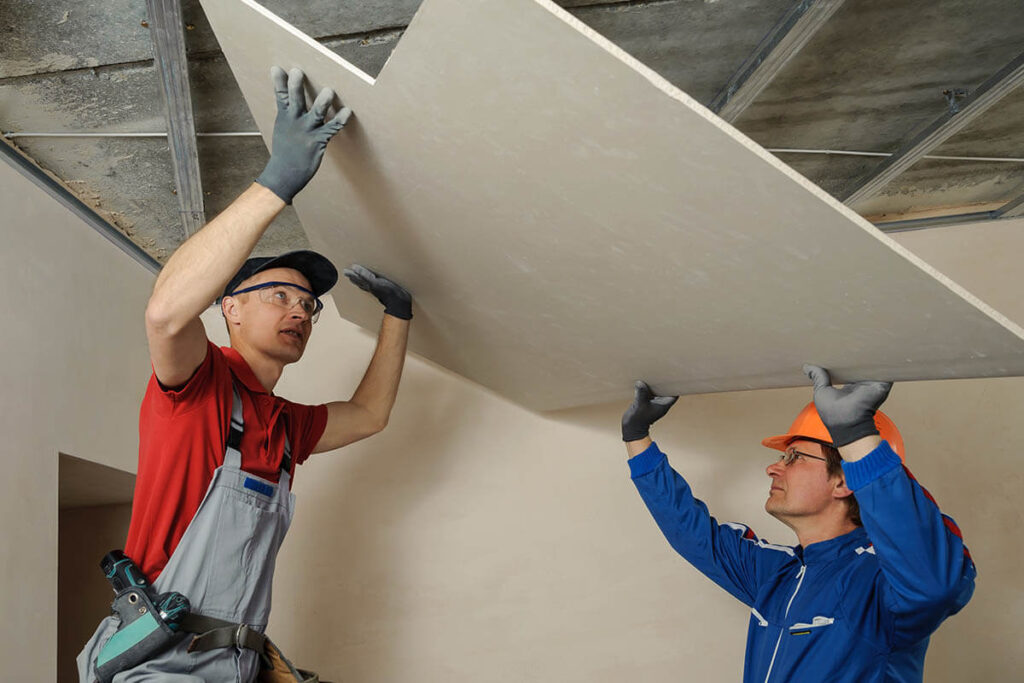Request Your Free Quote!

5 Signs You Need Professional Drywall Repair Drywall is a durable and versatile material, but over time, it can develop...

When it comes to interior walls, drywall and plaster are two of the most common materials used in homes and buildings. Both have been widely used for decades, but they differ in installation, durability, cost, and maintenance. Choosing the right material for your home can impact everything from appearance to energy efficiency. If you’re wondering whether drywall or plaster is better for your home, this guide will break down their key differences, pros and cons, and which option makes the most sense for your needs.
Drywall, also known as gypsum board or sheetrock, is a modern building material made from gypsum plaster sandwiched between two layers of paper. It comes in large panels and is screwed directly into the framing of a home, making it fast and easy to install. Drywall is the standard choice for most modern homes due to its affordability and ease of use.
✅ Faster Installation – Drywall is easy to cut, screw into place, and finish with joint compound.
✅ More Affordable – Drywall costs significantly less than traditional plaster.
✅ Easier Repairs – Small dents, holes, or cracks can be patched quickly with joint compound.
✅ Energy Efficient – Drywall offers good insulation and works well with modern heating and cooling systems.
✅ Versatile Finishes – Can be painted, textured, or wallpapered for a custom look.
❌ Less Durable – Drywall is softer than plaster and more prone to dents and holes.
❌ Not as Soundproof – Standard drywall does not block sound as well as plaster.
❌ Moisture Sensitivity – Standard drywall can be damaged by water leaks or high humidity (though moisture-resistant options exist).
Plaster is a more traditional wall material made from a mixture of water, lime, sand, and cement that is applied in layers over wooden lath strips or metal mesh. It was the primary method of wall construction before drywall became widely available in the mid-20th century. Plaster requires skilled labor for installation, but it creates a seamless, elegant, and durable finish that has stood the test of time.
✅ Highly Durable – Plaster is much harder and more impact-resistant than drywall.
✅ Smooth & Elegant Finish – Offers a superior, seamless look with a luxurious feel.
✅ Better Soundproofing – Thicker walls reduce noise transmission between rooms.
✅ Resistant to Mold & Fire – The material itself is less susceptible to mold and doesn’t burn easily.
❌ Expensive & Time-Consuming – Plaster requires skilled labor and takes longer to apply and dry.
❌ Difficult to Repair – Unlike drywall, plaster is harder to patch or replace if damaged.
❌ Can Crack Over Time – Plaster walls are prone to cracks due to house settling or temperature changes.
Feature | Drywall | Plaster |
Installation Time | ✅ Faster, easy to install | ❌ Requires skilled labor, longer drying time |
Durability | ❌ More prone to damage | ✅ Harder, more resistant to impacts |
Soundproofing | ❌ Standard sound insulation | ✅ Thick walls offer better noise reduction |
Repair & Maintenance | ✅ Easy to patch small holes | ❌ Cracks & damage are harder to fix |
Cost | ✅ Affordable | ❌ More expensive |
Aesthetic Appeal | ✅ Smooth, modern finish | ✅ Seamless, high-end look |
The decision between drywall vs. plaster depends on your budget, home style, and priorities.
✔️ Choose Drywall If…
✔️ Choose Plaster If…
Yes! Many homeowners combine both materials depending on the project:
For homeowners looking for a balance between durability and affordability, hybrid solutions using both drywall and plaster can be a great choice.
Whether you have cracked plaster walls or need drywall installation and repair, Just Like New Drywall Repairprovides expert services throughout Orange County, CA. Our team has decades of experience handling everything from small drywall patch jobs to full-scale plaster restoration.
Learn more about Drywall Repair Services.
Learn more about Plaster Repair Services.
📞 Call us today at (714) 639-9270 for a free consultation!

5 Signs You Need Professional Drywall Repair Drywall is a durable and versatile material, but over time, it can develop...

How to Identify and Repair Water Damage in Drywall Water damage is one of the most common issues homeowners face,...

The Most Common Drywall Repairs and How to Fix Them Drywall is one of the most common building materials used...

When it comes to interior walls, drywall and plaster are two of the most common materials used in homes and buildings. Both have been widely used for decades, but they differ in installation, durability, cost, and maintenance. Choosing the right material for your home can impact everything from appearance to energy efficiency. If you’re wondering whether drywall or plaster is better for your home, this guide will break down their key differences, pros and cons, and which option makes the most sense for your needs.
Drywall, also known as gypsum board or sheetrock, is a modern building material made from gypsum plaster sandwiched between two layers of paper. It comes in large panels and is screwed directly into the framing of a home, making it fast and easy to install. Drywall is the standard choice for most modern homes due to its affordability and ease of use.
✅ Faster Installation – Drywall is easy to cut, screw into place, and finish with joint compound.
✅ More Affordable – Drywall costs significantly less than traditional plaster.
✅ Easier Repairs – Small dents, holes, or cracks can be patched quickly with joint compound.
✅ Energy Efficient – Drywall offers good insulation and works well with modern heating and cooling systems.
✅ Versatile Finishes – Can be painted, textured, or wallpapered for a custom look.
❌ Less Durable – Drywall is softer than plaster and more prone to dents and holes.
❌ Not as Soundproof – Standard drywall does not block sound as well as plaster.
❌ Moisture Sensitivity – Standard drywall can be damaged by water leaks or high humidity (though moisture-resistant options exist).
Plaster is a more traditional wall material made from a mixture of water, lime, sand, and cement that is applied in layers over wooden lath strips or metal mesh. It was the primary method of wall construction before drywall became widely available in the mid-20th century. Plaster requires skilled labor for installation, but it creates a seamless, elegant, and durable finish that has stood the test of time.
✅ Highly Durable – Plaster is much harder and more impact-resistant than drywall.
✅ Smooth & Elegant Finish – Offers a superior, seamless look with a luxurious feel.
✅ Better Soundproofing – Thicker walls reduce noise transmission between rooms.
✅ Resistant to Mold & Fire – The material itself is less susceptible to mold and doesn’t burn easily.
❌ Expensive & Time-Consuming – Plaster requires skilled labor and takes longer to apply and dry.
❌ Difficult to Repair – Unlike drywall, plaster is harder to patch or replace if damaged.
❌ Can Crack Over Time – Plaster walls are prone to cracks due to house settling or temperature changes.
Feature | Drywall | Plaster |
Installation Time | ✅ Faster, easy to install | ❌ Requires skilled labor, longer drying time |
Durability | ❌ More prone to damage | ✅ Harder, more resistant to impacts |
Soundproofing | ❌ Standard sound insulation | ✅ Thick walls offer better noise reduction |
Repair & Maintenance | ✅ Easy to patch small holes | ❌ Cracks & damage are harder to fix |
Cost | ✅ Affordable | ❌ More expensive |
Aesthetic Appeal | ✅ Smooth, modern finish | ✅ Seamless, high-end look |
The decision between drywall vs. plaster depends on your budget, home style, and priorities.
✔️ Choose Drywall If…
✔️ Choose Plaster If…
Yes! Many homeowners combine both materials depending on the project:
For homeowners looking for a balance between durability and affordability, hybrid solutions using both drywall and plaster can be a great choice.
Whether you have cracked plaster walls or need drywall installation and repair, Just Like New Drywall Repairprovides expert services throughout Orange County, CA. Our team has decades of experience handling everything from small drywall patch jobs to full-scale plaster restoration.
Learn more about Drywall Repair Services.
Learn more about Plaster Repair Services.
📞 Call us today at (714) 639-9270 for a free consultation!

5 Signs You Need Professional Drywall Repair Drywall is a durable and versatile material, but over time, it can develop...

How to Identify and Repair Water Damage in Drywall Water damage is one of the most common issues homeowners face,...

The Most Common Drywall Repairs and How to Fix Them Drywall is one of the most common building materials used...

